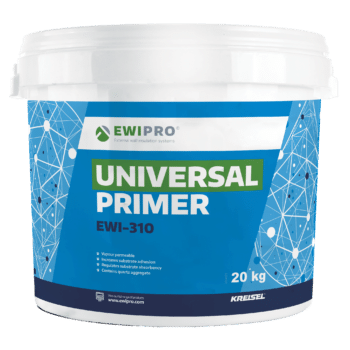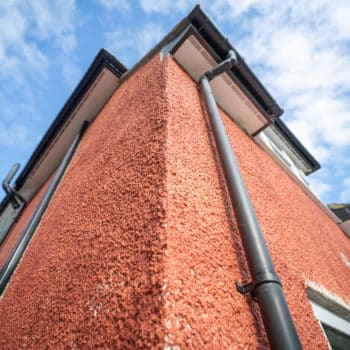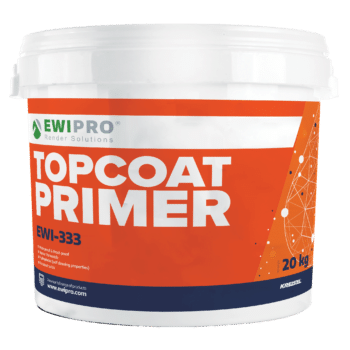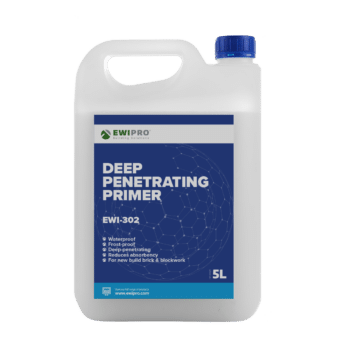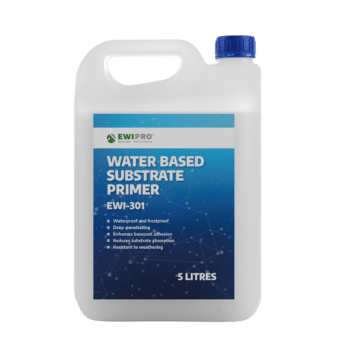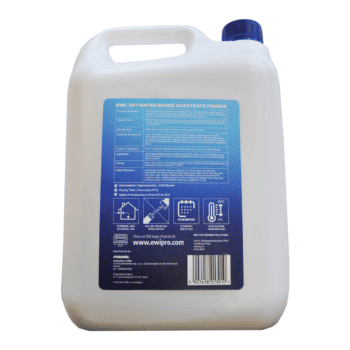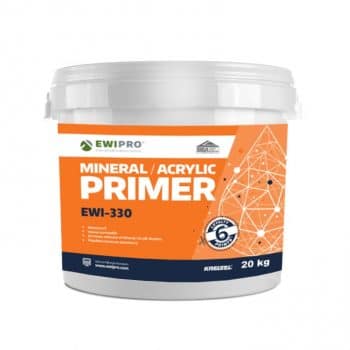How to Prepare a Substrate
In the world of construction, it’s often said that the final outcome is only as good as its foundation. When working with external wall insulation and render, this foundation is called the substrate. Ensuring the substrate is perfectly prepared is paramount to the longevity and aesthetics of the wall finish. This article sheds light on the critical steps to prepare a substrate, specifically focusing on repairing masonry and brick walls.
What is a substrate?
Before any repair or priming starts, the first step is always to remove any contaminants or imperfections. This includes:
- Dirt and Dust: Even a thin layer of dust can hinder adhesion. A clean substrate ensures the finishing material, whether it’s paint or render, adheres perfectly.
- Old Finishes: Old paint, sealant, or any previous finish should be stripped away to expose the raw substrate.
- Organic Growth: Mould, algae, or moss can severely compromise adhesion and might lead to health issues. It’s essential to ensure the substrate is free from any organic growth.
Imperfections, like cracks and holes, can compromise the final finish. Repairs ensure a smooth, even surface and can prevent underlying issues like moisture ingress. This stage includes:
- Filling Cracks and Holes: Small imperfections should be filled with the appropriate filler or mortar. EWI Levelling Mortar should be used to fill cracks in substrates.
- Levelling: For substrates with significant unevenness, levelling might be necessary. This provides a flat surface for the final finish.
This stage involves getting the substrate in the perfect condition to receive the finish. It includes:
- Priming: Primers can improve adhesion, prevent substrate moisture, and ensure a consistent finish. Primers also regulate the absorptivity of the surface whilst allowing moisture to escape. When incorporated into a breathable system, any potential residual dampness in the substrate can escape.
- Texturing: In some cases, a particular texture might be needed on the substrate to ensure the final material adheres correctly. Aggregates in primers can provide a more tactile surface for adhesion.
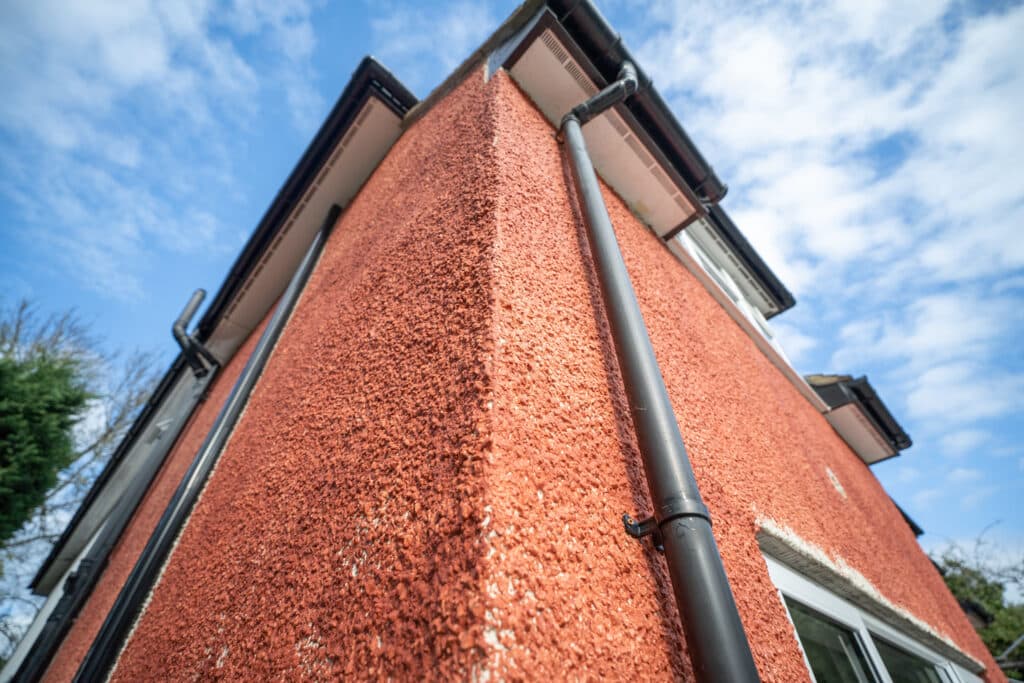
What impacts substrate preparation?
Every substrate, whether it’s brick, masonry, concrete, or plasterboard, comes with its unique set of characteristics. For instance, a porous substrate like brick absorbs more moisture compared to a dense one like concrete. This inherent porosity can affect how a primer or sealer is applied. A porous surface might require multiple coats or a special type of primer to ensure that subsequent layers adhere correctly. On the other hand, plasterboard might need specific treatments to prevent moisture damage or to create a surface suitable for tiling or rendering.
The ultimate goal of the finish significantly dictates the preparation process. Suppose you’re planning to tile a surface. In that case, the substrate might need waterproofing or a more textured finish to ensure that the adhesive bonds effectively. On the other hand, if you’re aiming for a painted or rendered finish, the emphasis would shift to creating a smooth, uniform surface. The choice of the finish material, be it tile adhesive, paint, or render, also comes with manufacturer-specific guidelines for substrate preparation. Adhering to these specifications is paramount to ensuring the longevity of the final finish.
The environment in which the substrate exists plays a pivotal role in its preparation. In areas with high humidity or rainfall, moisture resistance becomes a primary concern. Preparing a substrate in such conditions might require added steps, such as using waterproofing agents or vapour barriers. The temperature is another vital consideration. Some materials have optimal temperature ranges for application, impacting when and how substrate preparation occurs. For instance, certain primers or fillers might require longer curing times in colder temperatures.
Moreover, substrates in high-traffic areas or places exposed to chemicals might require additional reinforcement or specific treatments to ensure their durability.
Preparing a substrate – repairing small cracks
- Clean the Surface: Begin by brushing off loose particles, dirt, or old paint from the wall using a stiff bristle brush.
- Widen the Crack: For a more effective fix, use a chisel and hammer to slightly widen the crack. This provides a better grip for the filler.
- Apply Levelling Mortars or Basecoats: Choose a suitable mortar or basecoat for the substrate. Mix as directed and fill the cracks using a trowel or filling knife. Smooth it out, ensuring it’s level with the wall surface.
- Allow to Dry: Different mortars have varying drying times. Always follow manufacturer recommendations.
-
Universal Primer (EWI-310) – 20kg
Rated 4.40 out of 5£64.82 Incl. VAT£54.02 Excl. VAT£72.04 Incl. VAT£60.03 Excl. VAT -
Top Coat Primer (EWI-333)- 20kg
Rated 5.00 out of 5From £78.97 Incl. VATFrom £65.81 Excl. VAT -
Deep Penetrating Primer (EWI-302) – 5 Litres
£25.19 Incl. VAT£20.99 Excl. VAT -
Water Based Substrate Primer (EWI-301) – 5 Litres
Rated 5.00 out of 5£18.89 Incl. VAT£15.74 Excl. VAT -
Mineral & Acrylic Primer (EWI-330) – 20kg
Rated 4.00 out of 5£70.09 Incl. VAT£58.41 Excl. VAT
Why is Priming Essential?
1. Improving Adhesion: Primers are specially formulated to create a bond between the substrate and the final finish. Without this intermediary layer, renders, paints, or insulation might not adhere effectively, which leads to potential flaking, peeling, or premature wear.
2. Reducing Substrate Absorbency: Substrates like brick or plaster can be quite porous. A primer seals these pores, ensuring that the finishing layer does not sink into the substrate or get absorbed unevenly. This is essential for a uniform appearance and preventing “hot spots” where the finish might dry too quickly.
3. Providing an Even Base: Imperfections, even after repairs, can impact the appearance and performance of the final finish. Therefore, primers help in creating an even, consistent surface, masking minor blemishes and ensuring a uniform application of the finishing material.
The Process of Priming:
1. Selecting the Right Primer: The type of substrate and the intended final finish play a crucial role in primer selection. For instance, a masonry primer would be best suited for brick or concrete substrates, while a drywall primer would be ideal for plasterboard.
2. Surface Cleaning: Before primer application, the substrate should be free of dust, dirt, and grease. This can be achieved through thorough brushing or wiping down the surface.
3. Application: Using a brush, roller, or spray equipment, evenly apply the primer to the substrate. It is also vital to maintain a consistent coat without over-applying, which can lead to drips or pooling.
4. Drying Time: Allow the primer to dry as per the manufacturer’s recommendations. This can vary based on the type of primer and environmental conditions. A well-dried primer ensures optimal adhesion of the finishing layer.
5. Inspection: Before proceeding with the final finish, inspect the primed surface for any missed spots or inconsistencies. A uniformly primed substrate is the hallmark of a flawless final finish.
What happens if you don’t prepare a substrate?
The most immediate consequence of this oversight is poor adhesion. A well-prepared substrate allows the finishing material, whether it’s paint, render, or insulation, to cling effectively. In the absence of this preparation, uneven applications, unsightly air bubbles, or patchy regions emerge. As time advances, these imperfections evolve, manifesting as peeling, flaking, or blistering. Such disruptions not only tarnish the visual appeal but also usher in the need for often expensive and prolonged repairs.
Beyond adhesion, the visual impact of an improperly prepared substrate is quite stark. Blemishes distract from the overall appearance. Additionally, if a porous substrate isn’t primed, it can unevenly drink up the finish. Discoloured patches that either darken or lighten, disrupting the uniformity of the application.
An unprepared substrate becomes an unwitting gateway for moisture. Tiny cracks or gaps, often overlooked, morph into entry points for water, especially during periods of heavy rain or elevated humidity. The constant assault of moisture can slowly chip away at the substrate’s core strength, eroding its material, and jeopardising its structural integrity. Worse, this dampness becomes an inviting haven for mould and mildew. Their presence not only mars the aesthetics with their distinct black or green tinges but poses a significant health threat, especially for individuals with respiratory sensitivities.
The repercussions of skipping substrate preparation also carry a hefty price tag. When complications arise post-finish due to an unprepared base, the rectification isn’t straightforward. Repairing these after-effects is more labour-intensive and often costlier than if the substrate was prepped right from the outset. Furthermore, an inadequately prepared surface means the finish won’t last as long as it’s meant to, necessitating redoing the work much earlier. This, in turn, incurs additional material and labour expenditures.
Facebook
Twitter
LinkedIn
Your cart
Trade Account Login

We use cookies on our website to give you the most relevant experience by remembering your preferences and repeat visits. By clicking “Accept All”, you consent to the use of ALL the cookies. However, you may visit "Cookie Settings" to provide personalised consent.
Manage consent
Privacy Overview
This website uses cookies to improve your experience while you navigate through the website. Out of these, the cookies that are categorized as necessary are stored on your browser as they are essential for the working of basic functionalities of the website. We also use third-party cookies that help us analyze and understand how you use this website. These cookies will be stored in your browser only with your consent. You also have the option to opt-out of these cookies. But opting out of some of these cookies may affect your browsing experience.
Necessary cookies are absolutely essential for the website to function properly. These cookies ensure basic functionalities and security features of the website, anonymously.
| Cookie | Duration | Description |
|---|---|---|
| __stripe_mid | 1 year | This cookie is set by Stripe payment gateway. This cookie is used to enable payment on the website without storing any patment information on a server. |
| __stripe_sid | 30 minutes | This cookie is set by Stripe payment gateway. This cookie is used to enable payment on the website without storing any patment information on a server. |
| _GRECAPTCHA | 5 months 27 days | This cookie is set by the Google recaptcha service to identify bots to protect the website against malicious spam attacks. |
| apbct_cookies_test | session | CleanTalk sets this cookie to prevent spam on comments and forms and act as a complete anti-spam solution and firewall for the site. |
| apbct_page_hits | session | CleanTalk sets this cookie to prevent spam on comments and forms and act as a complete anti-spam solution and firewall for the site. |
| apbct_prev_referer | session | Functional cookie placed by CleanTalk Spam Protect to store referring IDs and prevent unauthorized spam from being sent from the website. |
| apbct_site_landing_ts | session | CleanTalk sets this cookie to prevent spam on comments and forms and act as a complete anti-spam solution and firewall for the site. |
| apbct_site_referer | 3 days | This cookie is placed by CleanTalk Spam Protect to prevent spam and to store the referrer page address which led the user to the website. |
| apbct_timestamp | session | CleanTalk sets this cookie to prevent spam on comments and forms and act as a complete anti-spam solution and firewall for the site. |
| apbct_urls | 3 days | This cookie is placed by CleanTalk Spam Protect to prevent spam and to store the addresses (urls) visited on the website. |
| AWSALBCORS | 7 days | This cookie is managed by Amazon Web Services and is used for load balancing. |
| cookielawinfo-checkbox-advertisement | 1 year | Set by the GDPR Cookie Consent plugin, this cookie is used to record the user consent for the cookies in the "Advertisement" category . |
| cookielawinfo-checkbox-analytics | 11 months | This cookie is set by GDPR Cookie Consent plugin. The cookie is used to store the user consent for the cookies in the category "Analytics". |
| cookielawinfo-checkbox-functional | 11 months | The cookie is set by GDPR cookie consent to record the user consent for the cookies in the category "Functional". |
| cookielawinfo-checkbox-necessary | 11 months | This cookie is set by GDPR Cookie Consent plugin. The cookies is used to store the user consent for the cookies in the category "Necessary". |
| cookielawinfo-checkbox-others | 11 months | This cookie is set by GDPR Cookie Consent plugin. The cookie is used to store the user consent for the cookies in the category "Other. |
| cookielawinfo-checkbox-performance | 11 months | This cookie is set by GDPR Cookie Consent plugin. The cookie is used to store the user consent for the cookies in the category "Performance". |
| ct_checkjs | session | CleanTalk–Used to prevent spam on our comments and forms and acts as a complete anti-spam solution and firewall for this site. |
| ct_fkp_timestamp | session | CleanTalk sets this cookie to prevent spam on the site's comments/forms, and to act as a complete anti-spam solution and firewall for the site. |
| ct_pointer_data | session | CleanTalk sets this cookie to prevent spam on the site's comments/forms, and to act as a complete anti-spam solution and firewall for the site. |
| ct_ps_timestamp | session | CleanTalk sets this cookie to prevent spam on the site's comments/forms, and to act as a complete anti-spam solution and firewall for the site. |
| ct_sfw_pass_key | 1 month | CleanTalk sets this cookie to prevent spam on comments and forms and act as a complete anti-spam solution and firewall for the site. |
| ct_timezone | session | CleanTalk–Used to prevent spam on our comments and forms and acts as a complete anti-spam solution and firewall for this site. |
| elementor | never | This cookie is used by the website's WordPress theme. It allows the website owner to implement or change the website's content in real-time. |
| viewed_cookie_policy | 11 months | The cookie is set by the GDPR Cookie Consent plugin and is used to store whether or not user has consented to the use of cookies. It does not store any personal data. |
Functional cookies help to perform certain functionalities like sharing the content of the website on social media platforms, collect feedbacks, and other third-party features.
| Cookie | Duration | Description |
|---|---|---|
| __zlcmid | 1 year | This cookie is used by Zendesk live chat and is used to store the live chat ID. |
| bcookie | 2 years | LinkedIn sets this cookie from LinkedIn share buttons and ad tags to recognize browser ID. |
| bscookie | 2 years | LinkedIn sets this cookie to store performed actions on the website. |
| lang | session | LinkedIn sets this cookie to remember a user's language setting. |
| lidc | 1 day | LinkedIn sets the lidc cookie to facilitate data center selection. |
| UserMatchHistory | 1 month | LinkedIn sets this cookie for LinkedIn Ads ID syncing. |
Performance cookies are used to understand and analyze the key performance indexes of the website which helps in delivering a better user experience for the visitors.
| Cookie | Duration | Description |
|---|---|---|
| __utma | 2 years | This cookie is set by Google Analytics and is used to distinguish users and sessions. The cookie is created when the JavaScript library executes and there are no existing __utma cookies. The cookie is updated every time data is sent to Google Analytics. |
| __utmb | 30 minutes | Google Analytics sets this cookie, to determine new sessions/visits. __utmb cookie is created when the JavaScript library executes and there are no existing __utma cookies. It is updated every time data is sent to Google Analytics. |
| __utmc | session | The cookie is set by Google Analytics and is deleted when the user closes the browser. It is used to enable interoperability with urchin.js, which is an older version of Google Analytics and is used in conjunction with the __utmb cookie to determine new sessions/visits. |
| __utmt | 10 minutes | Google Analytics sets this cookie to inhibit request rate. |
| __utmv | 2 years | The __utmv cookie is set on the user's device, to enable Google Analytics to classify the visitor. |
| __utmz | 6 months | Google Analytics sets this cookie to store the traffic source or campaign by which the visitor reached the site. |
| sib_cuid | 6 months | Purechat uses this cookie to send data to purechat.com, to connect visitors to the reservation team and track visitors to stay on portal. |
| SRM_B | 1 year 24 days | Used by Microsoft Advertising as a unique ID for visitors. |
Analytical cookies are used to understand how visitors interact with the website. These cookies help provide information on metrics the number of visitors, bounce rate, traffic source, etc.
| Cookie | Duration | Description |
|---|---|---|
| _ga | 2 years | The _ga cookie, installed by Google Analytics, calculates visitor, session and campaign data and also keeps track of site usage for the site's analytics report. The cookie stores information anonymously and assigns a randomly generated number to recognize unique visitors. |
| _gat_gtag_UA_61069204_2 | 1 minute | Set by Google to distinguish users. |
| _gat_UA-61069204-2 | 1 minute | A variation of the _gat cookie set by Google Analytics and Google Tag Manager to allow website owners to track visitor behaviour and measure site performance. The pattern element in the name contains the unique identity number of the account or website it relates to. |
| _gcl_au | 3 months | Provided by Google Tag Manager to experiment advertisement efficiency of websites using their services. |
| _gid | 1 day | Installed by Google Analytics, _gid cookie stores information on how visitors use a website, while also creating an analytics report of the website's performance. Some of the data that are collected include the number of visitors, their source, and the pages they visit anonymously. |
| _uetsid | 1 day | This cookies are used to collect analytical information about how visitors use the website. This information is used to compile report and improve site. |
| CONSENT | 2 years | YouTube sets this cookie via embedded youtube-videos and registers anonymous statistical data. |
Advertisement cookies are used to provide visitors with relevant ads and marketing campaigns. These cookies track visitors across websites and collect information to provide customized ads.
| Cookie | Duration | Description |
|---|---|---|
| _fbp | 3 months | This cookie is set by Facebook to display advertisements when either on Facebook or on a digital platform powered by Facebook advertising, after visiting the website. |
| ANONCHK | 10 minutes | The ANONCHK cookie, set by Bing, is used to store a user's session ID and also verify the clicks from ads on the Bing search engine. The cookie helps in reporting and personalization as well. |
| fr | 3 months | Facebook sets this cookie to show relevant advertisements to users by tracking user behaviour across the web, on sites that have Facebook pixel or Facebook social plugin. |
| MUID | 1 year 24 days | Bing sets this cookie to recognize unique web browsers visiting Microsoft sites. This cookie is used for advertising, site analytics, and other operations. |
| NID | 6 months | NID cookie, set by Google, is used for advertising purposes; to limit the number of times the user sees an ad, to mute unwanted ads, and to measure the effectiveness of ads. |
| test_cookie | 15 minutes | The test_cookie is set by doubleclick.net and is used to determine if the user's browser supports cookies. |
| uuid | 6 months | MediaMath sets this cookie to avoid the same ads from being shown repeatedly and for relevant advertising. |
| VISITOR_INFO1_LIVE | 5 months 27 days | A cookie set by YouTube to measure bandwidth that determines whether the user gets the new or old player interface. |
| YSC | session | YSC cookie is set by Youtube and is used to track the views of embedded videos on Youtube pages. |
| yt-remote-connected-devices | never | YouTube sets this cookie to store the video preferences of the user using embedded YouTube video. |
| yt-remote-device-id | never | YouTube sets this cookie to store the video preferences of the user using embedded YouTube video. |
| yt.innertube::nextId | never | This cookie, set by YouTube, registers a unique ID to store data on what videos from YouTube the user has seen. |
| yt.innertube::requests | never | This cookie, set by YouTube, registers a unique ID to store data on what videos from YouTube the user has seen. |
Other uncategorized cookies are those that are being analyzed and have not been classified into a category as yet.
| Cookie | Duration | Description |
|---|---|---|
| _clck | 1 year | No description |
| _clsk | 1 day | No description |
| _uetvid | 1 year 24 days | No description available. |
| AnalyticsSyncHistory | 1 month | No description |
| apbct_pixel_url | session | No description |
| apbct_visible_fields_0 | session | No description |
| apbct_visible_fields_1 | session | No description |
| apbct_visible_fields_10 | session | No description |
| apbct_visible_fields_2 | session | No description |
| apbct_visible_fields_3 | session | No description |
| apbct_visible_fields_4 | session | No description |
| apbct_visible_fields_5 | session | No description |
| apbct_visible_fields_6 | session | No description |
| apbct_visible_fields_7 | session | No description |
| apbct_visible_fields_8 | session | No description |
| apbct_visible_fields_9 | session | No description |
| ct_checked_emails | session | No description |
| ct_has_scrolled | session | No description |
| ct_mouse_moved | session | No description |
| ct_screen_info | session | No description |
| ictf_master | never | No description available. |
| li_gc | 2 years | No description |
| m | 2 years | No description available. |
| SM | session | No description available. |
| testinfinitycookie | session | No description |
| woocommerce_show_tax | 7 days | No description available. |
| wp_woocommerce_session_c5ac76b408021294cb56bcc27eddf8a1 | 2 days | No description |


